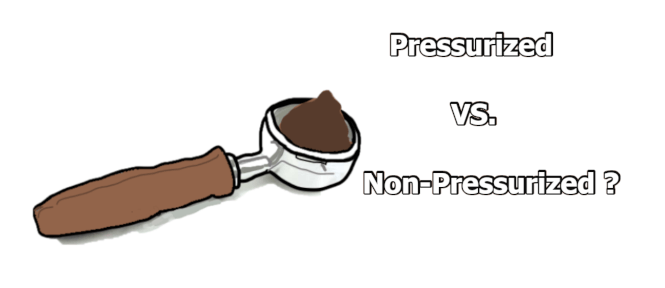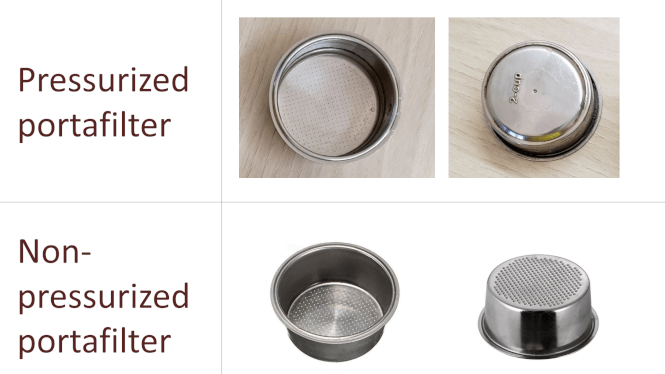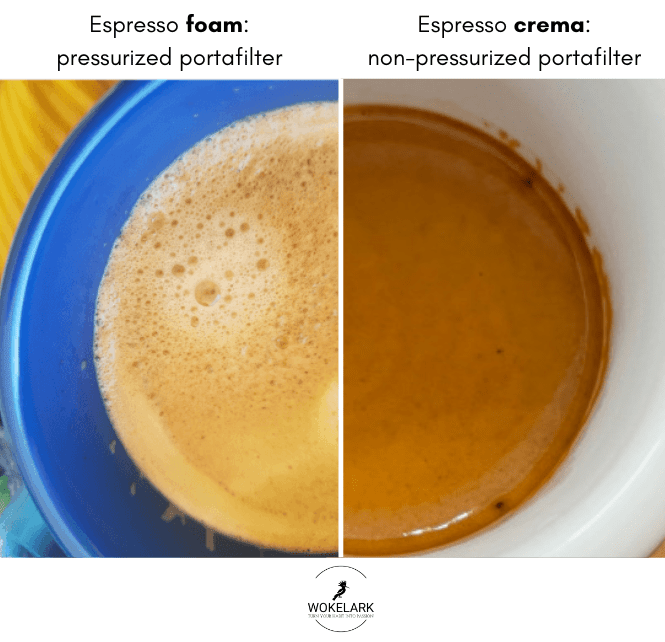Ten-fifteen years back my father and I were looking to buy a high-quality espresso machine that my mother, famous for her exquisite palate and love for coffee, would like.
During our research, I first became aware of the existence of the dual-wall pressurized portafilters and their single-walled ancestors.
If you’re looking for your first espresso machine, I’m pretty sure you’ve stumbled upon those two options.
But which one should you choose to make your coffee with?
Is there a significant difference between the coffee made with a pressurized portafilter and the one made with a non-pressurized basket?
What is the grind size that you should use having one or the other?
Maybe you’ve heard that dual wall filters are bad and don’t make a “real espresso”.
Then what are you having if you’ve been using the pressurized version ever since you’ve had your espresso machine at home, and what difference does it bear compared to a non-pressurized filter?
If you feel like something is missing and you want to master the extraction and the overall taste and quality, it might be good for you to check if the portafilter you’re using is the one that can produce the coffee of your dreams.
So let’s dive in and explain all you need to know.
What Is the Difference When It Comes to Pressurized Versus a Non-pressurized Portafilter?
In order for you to find out which one will suit you best, you need to understand what are their basic characteristics.
Here is the difference between pressurized and non-pressurized portafilters:
In its essence, espresso needs to have a decent extraction of emulsified coffee oils, which can be best achieved through a finer size of the grind.
Non-pressurized portafilters work with such espresso fine grind.
The tamped coffee grounds provide the resistance and serve to build the needed 8-9 bars of pressure in the basket.
This forces gases out of the grounds, and the overall extraction results in a rich-tasting and balanced espresso with great crema, emulsified with coffee proteins and oils.
However, with pressurized portafilters, the grind needs to be coarser because the fine espresso grind blocks the dual-wall basket mechanism and doesn’t allow water pressure to build in and open the tiny valve.
This would choke the coffee machine.
When using pressurized portafilter the coffee is being forced through a small hole which results in aeration, producing faux crema (foam).
For these reasons, the coffee made with pressurized portafilter isn’t as good as the espresso made with a non-pressurized filter basket.
A pressurized basket doesn’t allow for an extraction process that will result in a classic espresso taste and mouthfeel.
Mechanical dissimilarities between the baskets
You can tell the difference between the two filter baskets easily.
With the pressurized portafilter, the coffee goes through two screens.
The internal one looks just like a standard espresso basket with lots of holes spread evenly on it.
This is where you place your coffee grounds.
After the water passes through the grounds, extracting them, it enters the holding area, between the first and the second screen, where the machine pressure builds up and the coffee gets pushed through a tiny hole (sometimes the holes are two).
This is why pressurized portafilters are also called dual-wall filter baskets.
Even without you placing any coffee in the basket, some pressure can build, because of this mechanism.
When 9 bars of pressure are reached the coffee starts pouring down, entering your coffee cup.

Photo of a naked non-pressurized portafilter made by Janko Ferlic from Pexels
Non-pressurized portafilters were the ones put into work when espresso was first made and nowadays – where espresso is properly made.
If you manage to get the hang of using it properly, you will end up with a beautiful cup of full-bodied coffee with a nuanced taste and satisfying intense crema.
But is taking time to get the hang of it really worth it in your case?
Which One Will Suit You Best at Home?
Now that you know the basic differences between the espresso coffee filter baskets we’re currently discussing, and between the coffee they produce, you may quickly jump to the conclusion that you want the single wall filter basket.
After all, we all want to have the best possible espresso at home.
But as I already mentioned, if you want to upgrade to a non-pressurized portafilter you need to take some time to figure out the way to use it.
Not only that:
When brewing with a single wall basket for espresso you also need to make sure you use good quality, freshly roasted beans.
That comes on top of experimenting with the dose, grind, distribution, and tamping.
Whole coffee beans can be considered fresh for only 3 days after opening the valve-sealed bag.
My first barista trainer taught me this.
He also made sure we made espresso with freshly ground beans that have gone through the grinder within the last 3 hours.
He was serious about us making high-quality espresso. He insisted we know that after the third hour post grinding the coffee grounds produce a stale cup because of their contact with the oxygen.
To be fair, with time I learned that if you want to make exceptional espresso, you should grind right before pulling a shot.
I actually start noticing a considerable difference in espresso’s overall quality after leaving the ground beans in the grinder’s container for only 15 minutes.
Furthermore, during the practice exam of my Espresso Acedemy barista training, I had to make sure that I start the espresso extraction within 5 seconds after securing the portafilter to the group head. Leaving the ground beans in the heated portafilter basket for longer would further deteriorate the flavor.
Related Post: How Long do Coffee Beans Last
To perserve the flavor of ground coffee beans at home is best to keep them in an airtight container with a CO2 valve.
It’s essential to also point out that not all grinders can achieve a proper espresso grind.
If you are planning on using a non-pressurized portafilter you have to invest in an adequate grinder that can produce a consistent high-end espresso grind out of your freshly roasted coffee beans.
You will have to invest at least $400 – $500 in a new grinder.
If you ask me all that is totally worth it.
If you appreciate a classy espresso you should be looking at something like this.
I love having total control over the brewing process, knowing that I use high-quality products that are capable of producing a high-quality espresso taste.
Check out this beginner-friendly guide on the best water for coffee to find out more.
I also quite enjoy the process of preparing coffee with the non-pressurized filter basket.
Ever since I got the hang of it I have impressed quite a few of my friends with my espresso-making skills.
They love making fun of how serious I am about coffee making, but in the end, they all enjoy what I’ve prepared.
A dual wall is a great option if you have a lower-end grinder or if you tend to use store-bought pre-ground coffee and you’re satisfied with its taste.
The pressurized portafilter exists to ease the brewing process.
You shouldn’t be that precise with all the variables that non-pressurized portafilters are highly sensitive to.
You will get consistent results with the coffee, even if the level of tamping, the coffee grind, and the dose differ between each brew.
Overall you won’t have to spend as much money and you will get an easier cup of coffee.
And if you don’t mind that with pressurized portafilter you won’t get to have a real espresso by the book.
In comparison to the real espresso, the one you’ll get with the pressurized filter basket will have somewhat stable, but rather airy foam, and a thinner body.
If you’re used to the original taste – you will notice that the result you’ll get isn’t as rich in flavor as you’d expect.
But if that isn’t an issue in your case, you can get a satisfying cup of coffee at home each morning with the dual wall.
And when you feel like spoiling yourself with a high-quality espresso – go to a café and order one.
This way you will enjoy it even more.
Conclusion
I hope I managed to help you out and now you know which type of portafilter is the one for you.
You may decide that the battle of the pressurized versus the non-pressurized one is won by the double-wall filter basket.
However, in time you might want to dive deeper into the world of coffee and upgrade to a higher-end grinder and a single wall filter.
To those that feel the urge to dive in sooner – congratulations!
The single wall portafilter is worth the hassle.
I plan on writing an article to give you a detailed guide on how to use the non-pressurized portafilter to ease your journey as a beginner.
Edit: The article is already written, you can check it out here: How to Pull an Espresso Shot: Full Guide with Photos.
But now let me know what your thoughts are in the comments below.
Which one did you choose and why?




I’ve never seen a blind taste test comparing pressurized with non-pressurized portafilters. Very suspicious to me. I would be interested to see this done, but that could erase espresso making dogma.
When the above article was written back in 2019 the following statement was made… “I plan on writing an article to give you a detailed guide on how to use the non-pressurized portafilter to ease your journey as a beginner. ”
Does anyone know if that article was ever written? And, if so, How do I link to it?
Thanks
———————————————————————————–
Great info, great thread, great comments from the readers, and very little attitude… Love it!
Thank you everybody.
Having already learned quite a lot has only made me aware of how much more I don’t know yet. Even so, I have managed to improve the taste of my coffee substantially from when I first started. My Ristretto has now become, to me, better than any other I’ve tried (Of course, living in rural Georgia, where most local “baristas” have never heard of “Ristretto”, being ‘my’ best may not mean a whole lot.)
Hi Veritas, thanks for leaving a comment. I’m sorry that I haven’t managed to reply sooner. I’m back, working on my blog more seriously. Your comment motivated me to write and publish the long overdue espresso guide. It’s named “How to pull an espresso shot”. You can find a link to it at the end of this post. You are even mentioned in the last section of the guide 🙂 So thanks again for inspiring me to take some time and finish what I was planning to for so long.
I am just starting my exploration into making espresso drinks at home. This article clarified much for me and as a beginner with $7 in for a Saeco Via Venzia/Starbucks Barista I like the idea of the pressurized portafilter to start. Thanks for the information!
Another point here is that the coffee path in most pressurized filters runs over plastic parts. The traditional non pressure type does not…
Hi,
It is the most comprehensive approach on this topic. I could not realize why my home-made coffee is different now with Krups non-pressurized portafilter. I used to have Saeco with pressurized system, and cream/foam was very rich and I liked it. But, know, it is better taste, even without that rich cream.
After reading this i am glad for that 🙂
Thank you for open my eyes widely,
Zoran
Hi there! Such an excellent approach to this topic! I’m from uruguay and have the cheapest machine i could get but it says to be 20b (which i guess could be 8-10 at the end) and been trying to know if buying a non-pressurized filter would be ok.
Definetly worth it based on your post.
I was wondering the same thing, have a machine that came with pressurised filter, can I just buy a new portafilter and grinder so I can use both with the same machine?
Yes you can BUT you need a good quality grinder otherwise you will find that the coffee sprays out of the top. I have just changed my grinder and the non-pressurised portafilter now does not spray. I am still experimenting with the grind and the tamping which are more important in a non-pressurised portafilter. Good luck and good coffee.
There’s no such thing as faux crema. Both produce crema, it’s just that the pressurized version is aerated and lower in quantity because the coarse ground surface area of the coffee exposed to the steam is smaller.
The whole purpose for pressurized baskets is so you can use ground coffee off the shelf from the supermarket, which allows you a wider selection of coffees. Because supermarkets stock more ground coffee than whole beans.
Having a pressurized basket machine (some work with both basket types) allows me to have a cheap sologrind burr grinder that isn’t consistent, but gives me the benefits of a fresh ground bean.
Additionally, if you enjoy lattes, then crema content is not as important. I love coffee, especially good coffee, but on a daily basis I drink lattes with a plain Noni’s biscotti, or two. If I had all the time in the world, then I could be really particular about my coffee (but I’m not a snob…those people are pretentious and annoying), but if you are trying to imitate your daily Starbucks fix, pressurized baskets are simple, fast and produce good quality coffee. This week I will try some Gevalia traditional roast beans, a BOGO I found at Publix. Last week it was Community Coffee beans. The week before…Kona coffee beans. I like this diversity better than good crema.
However, if straight espresso is your thing, then you probably want a non-pressurized basket machine, some small cups and saucers, and a bunch of lemon rinds to impress your soon to be aquatintence friends.